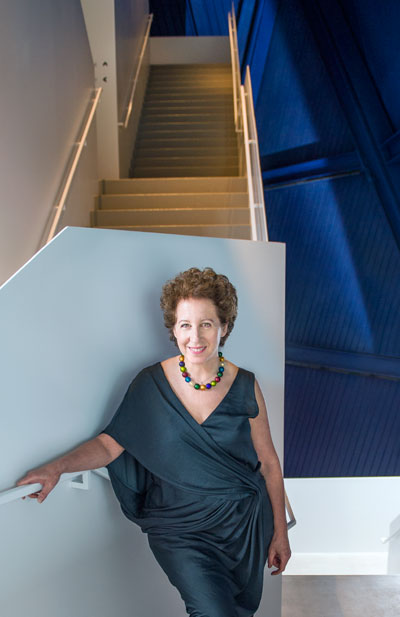|
Jill Snyder,Executive Director MOCA Cleveland, Executive Director MOCA Cleveland 2013 MARTHA JOSEPH PRIZE
“The arts and being surrounded by artists is very natural to me, because it was part of my family upbringing,” she says. Maybe so much so that she chose not to study the visual arts in college. Instead, she majored in literature and language, graduating with her BA from Wesleyan University in 1979. She also became enthralled with modern dance and choreography and spent a brief time pursuing a dance career in San Francisco. “I quickly realized I wasn’t talented enough to be an artist,” she says with a laugh. “But I loved thinking about how artists made their work and realized that thinking about it rather than doing it was the path for me.” Jill took a giant leap along that path when she moved to New York and was hired as the executive assistant to the eminent director of the Solomon R. Guggenheim Museum, Thomas Messer. Working for Messer the last seven years of his threedecade tenure, she says, enabled her to experience the world of contemporary and modern art on a level she had never imagined. Once again, she found herself surrounded by acclaimed artists such as Robert Rauschenberg, who even signed a Guggenheim poster for her. “That time really solidified for me that I loved to be around the arts, that I loved being in museums,” Jill says. “I had friends in the field who were in the academic world and wanted to teach and do research, but I preferred the application of art through public exhibitions and programming.” From her professional experience, Jill knew she had two of the three legs she needed to direct a museum: public communication and management skills. However, she would need to return to school to acquire the third leg: a concentration in arts education and history, which she attained through graduate study in art history at NYU’s Institute of Fine Art. In 1996, after a short stint in leadership roles at two small regional museums, she was hired to guide the Cleveland Center for Contemporary Art, which she later renamed MOCA Cleveland. She and the Board knew that they would have to move out of the Cleveland Play House, an “island” location that isolated them from a regular flow of pedestrian traffic. By 2000, she began to lead the initiative that resulted in a sparkling, iconic edifice that anchors the new Uptown District of University Circle. Since opening in October 2012, MOCA has already doubled its highest annual attendance figure of 20,000 in the previous space. Roughly half of those visitors have never been to a contemporary art museum before. Snyder helmed the construction process through a decade that included surviving the global financial crisis and ensuing great recession, points out Stewart Kohl, co-CEO of the Riverside Company and MOCA Board member and co-chair of its capital campaign. “Jill has the intelligence, perseverance and ability to imagine the future and make it happen,” he attests. “Having both vision and execution in one person is unusual.” Today, Jill says she finds deep inspiration in working closely with the artists MOCA features, as well as in her brother, Gary, who runs the family’s gallery in New York, and her sister, Kim, a documentary filmmaker. She also treasured working with Farshid Moussavi, architect for the new MOCA building. “Farshid raised the bar high, pushing and teaching me about the quality of space and how architecture shapes experience,” she states. Her plans for MOCA’s future? “We need to learn what we do well in this building and maximize our potential for our vision,” Jill says. “Then we can grow into our skin, establish a sustainable operating model and fully realize the energy of our audience and this amazingly vibrant district.”
|
 Jill Snyder was born to be a museum director. Well, almost. Although her father worked by day at Snyder’s, his family’s sporting goods store in Trenton, NJ, he was a professional artist who had trained at Tyler School of Art at Temple University. She and her siblings were often the subject of his expressionistic portraits, posing in their laundry room which doubled as his studio. When she was 13, her parents decided to open an art gallery in Princeton, and her father later spent the last 20 years of his life painting.
Jill Snyder was born to be a museum director. Well, almost. Although her father worked by day at Snyder’s, his family’s sporting goods store in Trenton, NJ, he was a professional artist who had trained at Tyler School of Art at Temple University. She and her siblings were often the subject of his expressionistic portraits, posing in their laundry room which doubled as his studio. When she was 13, her parents decided to open an art gallery in Princeton, and her father later spent the last 20 years of his life painting.